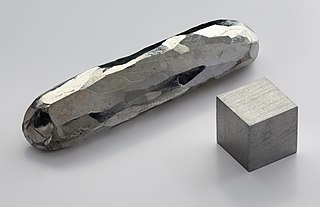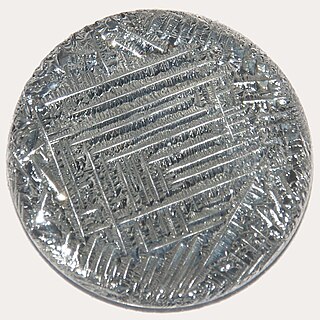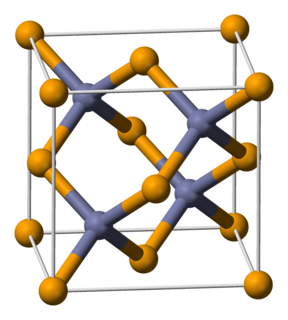Related Research Articles

Cadmium is a chemical element with the symbol Cd and atomic number 48. This soft, silvery-white metal is chemically similar to the two other stable metals in group 12, zinc and mercury. Like zinc, it demonstrates oxidation state +2 in most of its compounds, and like mercury, it has a lower melting point than the transition metals in groups 3 through 11. Cadmium and its congeners in group 12 are often not considered transition metals, in that they do not have partly filled d or f electron shells in the elemental or common oxidation states. The average concentration of cadmium in Earth's crust is between 0.1 and 0.5 parts per million (ppm). It was discovered in 1817 simultaneously by Stromeyer and Hermann, both in Germany, as an impurity in zinc carbonate.

Tellurium is a chemical element with the symbol Te and atomic number 52. It is a brittle, mildly toxic, rare, silver-white metalloid. Tellurium is chemically related to selenium and sulfur, all three of which are chalcogens. It is occasionally found in native form as elemental crystals. Tellurium is far more common in the Universe as a whole than on Earth. Its extreme rarity in the Earth's crust, comparable to that of platinum, is due partly to its formation of a volatile hydride that caused tellurium to be lost to space as a gas during the hot nebular formation of Earth.
The Cowan–Reines neutrino experiment was conducted by Washington University in St. Louis alumnus Clyde L. Cowan and Stevens Institute of Technology and New York University alumnus Frederick Reines in 1956. The experiment confirmed the existence of neutrinos. Neutrinos, subatomic particles with no electric charge and very small mass, had been conjectured to be an essential particle in beta decay processes in the 1930s. With neither mass nor charge, such particles appeared to be impossible to detect. The experiment exploited a huge flux of electron antineutrinos emanating from a nearby nuclear reactor and a detector consisting of large tanks of water. Neutrino interactions with the protons of the water were observed, verifying the existence and basic properties of this particle for the first time.

In nuclear physics, double beta decay is a type of radioactive decay in which two neutrons are simultaneously transformed into two protons, or vice versa, inside an atomic nucleus. As in single beta decay, this process allows the atom to move closer to the optimal ratio of protons and neutrons. As a result of this transformation, the nucleus emits two detectable beta particles, which are electrons or positrons.

The neutrinoless double beta decay (0νββ) is a commonly proposed and experimentally pursued theoretical radioactive decay process that would prove a Majorana nature of the neutrino particle. To this day, it has not been found.

Cadmium telluride (CdTe) is a stable crystalline compound formed from cadmium and tellurium. It is mainly used as the semiconducting material in cadmium telluride photovoltaics and an infrared optical window. It is usually sandwiched with cadmium sulfide to form a p–n junction solar PV cell.

Hg1−xCdxTe or mercury cadmium telluride is a chemical compound of cadmium telluride (CdTe) and mercury telluride (HgTe) with a tunable bandgap spanning the shortwave infrared to the very long wave infrared regions. The amount of cadmium (Cd) in the alloy can be chosen so as to tune the optical absorption of the material to the desired infrared wavelength. CdTe is a semiconductor with a bandgap of approximately 1.5 electronvolts (eV) at room temperature. HgTe is a semimetal, which means that its bandgap energy is zero. Mixing these two substances allows one to obtain any bandgap between 0 and 1.5 eV.

Cadmium zinc telluride, (CdZnTe) or CZT, is a compound of cadmium, zinc and tellurium or, more strictly speaking, an alloy of cadmium telluride and zinc telluride. A direct bandgap semiconductor, it is used in a variety of applications, including semiconductor radiation detectors, photorefractive gratings, electro-optic modulators, solar cells, and terahertz generation and detection. The band gap varies from approximately 1.4 to 2.2 eV, depending on composition.

Zinc telluride is a binary chemical compound with the formula ZnTe. This solid is a semiconductor material with a direct band gap of 2.26 eV. It is usually a p-type semiconductor. Its crystal structure is cubic, like that for sphalerite and diamond.
Mercury zinc telluride is a telluride of mercury and zinc, an alloy of mercury telluride and zinc telluride. It is a narrow-gap semiconductor material.
Inverse beta decay, commonly abbreviated to IBD, is a nuclear reaction involving an electron antineutrino scattering off a proton, creating a positron and a neutron. This process is commonly used in the detection of electron antineutrinos in neutrino detectors, such as the first detection of antineutrinos in the Cowan–Reines neutrino experiment, or in neutrino experiments such as KamLAND and Borexino. It is an essential process to experiments involving low-energy neutrinos such as those studying neutrino oscillation, reactor neutrinos, sterile neutrinos, and geoneutrinos. The IBD reaction can only be used to detect antineutrinos due to lepton conservation.
Cadmium tungstate (CdWO4 or CWO), the cadmium salt of tungstic acid, is a dense, chemically inert solid which is used as a scintillation crystal to detect gamma rays. It has density of 7.9 g/cm3 and melting point of 1325 °C. It is toxic if inhaled or swallowed. Its crystals are transparent, colorless, with slight yellow tint. It is odorless. Its CAS number is . It is not hygroscopic.

Zinc phosphide (Zn3P2) is an inorganic chemical compound. It is a grey solid, although commercial samples are often dark or even black. It is used as a rodenticide. Zn3P2 is a II-V semiconductor with a direct band gap of 1.5 eV and may have applications in photovoltaic cells. A second compound exists in the zinc-phosphorus system, zinc diphosphide (ZnP2).
The Neutrino Ettore Majorana Observatory is an international collaboration of scientists searching for neutrinoless double beta decay (0νββ). The collaboration has been active since 1989. Observation of 0νββ would indicate neutrinos are Majorana particles and could be used to measure the neutrino mass. It is located in the Modane Underground Laboratory (LSM) in the Fréjus Road Tunnel. The experiment has had 3 detectors, NEMO-1, NEMO-2, NEMO-3 and is planning to construct a new detector SuperNEMO. The NEMO-1 and NEMO-2 prototype detectors were used until 1997. Latest experiment NEMO-3 was under design and construction from 1994 onwards, took data from January 2003 to January 2011 and the final data analysis was published in 2018. The NEMO-2 and NEMO-3 detectors produced measurements for double neutrino decays and limits for neutrinoless double-beta decay for a number of elements, such as molybdenum-100 and selenium-82. These double beta decay times are important contributions to understanding the nucleus and are needed inputs for neutrinoless decay studies, which constrain neutrino mass.

The MAJORANA project is an international effort to search for neutrinoless double-beta (0νββ) decay in 76Ge. The project builds upon the work of previous experiments, notably those performed by the Heidelberg–Moscow and IGEX collaborations, which used high-purity germanium (HPGe) detectors, to study neutrinoless double-beta decay.

X-ray detectors are devices used to measure the flux, spatial distribution, spectrum, and/or other properties of X-rays.
High energy X-ray imaging technology (HEXITEC) is a family of spectroscopic, single photon counting, pixel detectors developed for high energy X-ray and gamma ray spectroscopy applications.

The Cryogenic Underground Observatory for Rare Events (CUORE[ˈkwɔːre], also Italian for 'heart') is a particle physics facility located underground at the Laboratori Nazionali del Gran Sasso in Assergi, Italy. CUORE was designed primarily as a search for neutrinoless double beta decay in 130Te, a process that has never been observed. It uses tellurium dioxide (TeO2) crystals as both the source of the decay and as bolometers to detect the resulting electrons. CUORE searches for the characteristic signal of neutrinoless double beta decay, a small peak in the observed energy spectrum around the known decay energy; for 130Te, this is Q = 2527.518 ± 0.013 keV. CUORE can also search for signals from dark matter candidates, such as axions and WIMPs.
The Germanium Detector Array experiment was searching for neutrinoless double beta decay (0νββ) in Ge-76 at the underground Laboratori Nazionali del Gran Sasso (LNGS). Neutrinoless beta decay is expected to be a very rare process if it occurs. The collaboration predicted less than one event each year per kilogram of material, appearing as a narrow spike around the 0νββ Q-value in the observed energy spectrum. This meant background shielding was required to detect any rare decays. The LNGS facility has 1400 meters of rock overburden, equivalent to 3000 meters of water shielding, reducing cosmic radiation background. The GERDA experiment was operated from 2011 onwards at LNGS.

Yuri G. Zdesenko ; 6 October 1943 – 1 September 2004, was a Ukrainian nuclear physicist known for a significant contribution to investigations of double beta decay.
References
- ↑ Wilson, J. R. (2008). "The COBRA experiment". Journal of Physics: Conference Series. 120 (5): 052048. doi: 10.1088/1742-6596/120/5/052048 . ISSN 1742-6596.
- 1 2 Ebert, J.; et al. (2016-01-21). "The COBRA demonstrator at the LNGS underground laboratory". Nuclear Instruments and Methods in Physics Research Section A: Accelerators, Spectrometers, Detectors and Associated Equipment. 807: 114–120. arXiv: 1507.08177 . Bibcode:2016NIMPA.807..114E. doi:10.1016/j.nima.2015.10.079. ISSN 0168-9002. S2CID 110688200.
- ↑ Bloxham, T.; et al. (2007-08-03). "First results on double β-decay modes of Cd, Te, and Zn Isotopes". Physical Review C. 76 (2): 025501. arXiv: 0707.2756 . Bibcode:2007PhRvC..76b5501B. doi:10.1103/PhysRevC.76.025501. S2CID 119257817.
- 1 2 3 Ebert, J.; et al. (2013). "Current Status and Future Perspectives of the COBRA Experiment". Advances in High Energy Physics. 2013: 1–6. doi: 10.1155/2013/703572 . ISSN 1687-7357.